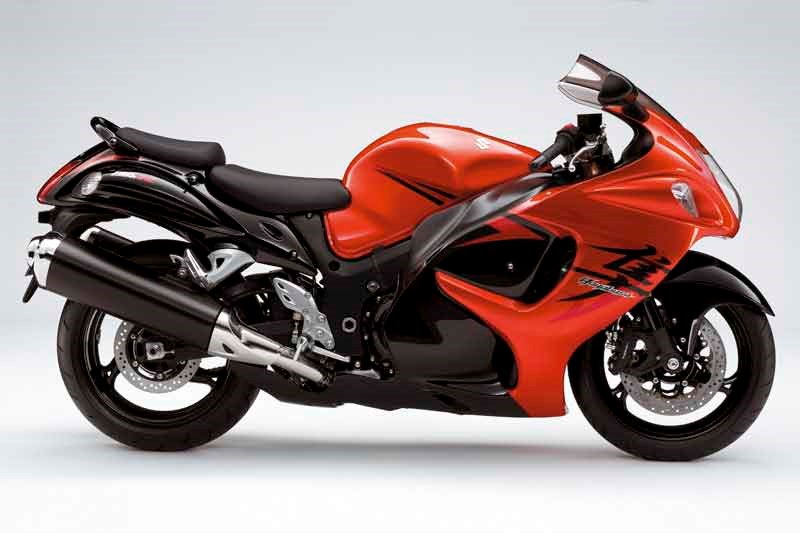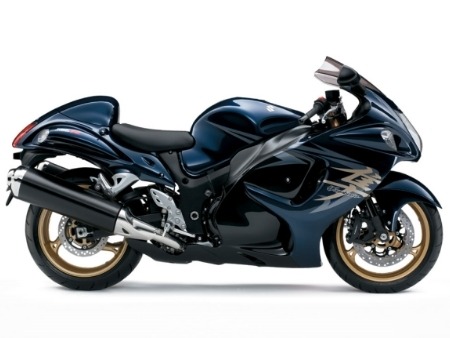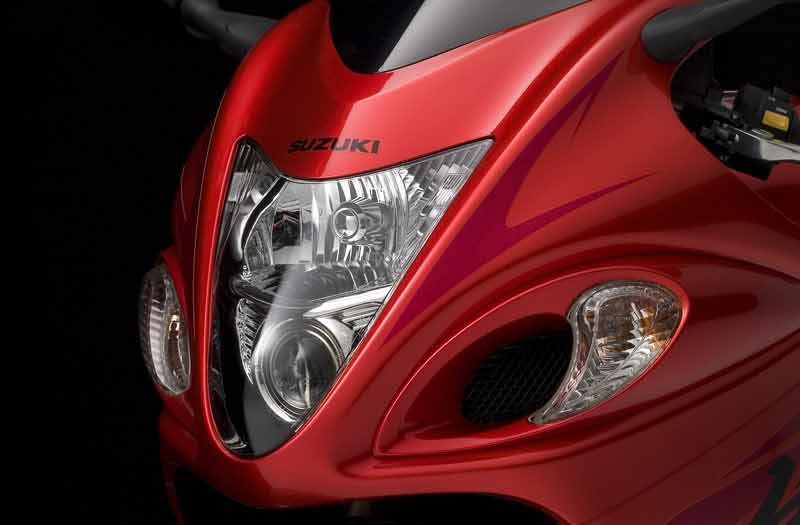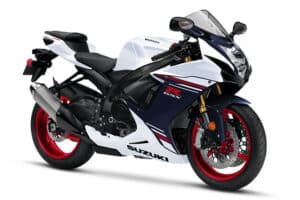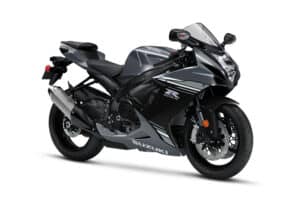A Performance Legend
Hayabusa. It is a sporting motorcycle that has become a performance legend in its own time. An aerodynamic machine inspired by and named after a Japanese peregrine falcon known for cutting through the wind with incredible ease.
A machine so unique when it was introduced that it required its own new classification: Ultimate Sport.
A motorcycle so exciting that it has developed a devoted following around the world. A motorcycle so amazing that it has outsold its would-be competitors across a span of almost 10 years.
Combining seemingly effortless acceleration, wind-cheating aerodynamics, sporty handling, timeless style, long-distance comfort and unlimited excitement. Built to deliver balanced performance.
A legend Reborn
Introducing the 2008 Suzuki Hayabusa. Updated to reach new levels of engine efficiency and smooth drivability, with more displacement and broader torque throughout the rpm range, a better power-to-weight ratio and lower emissions. Offering improved aerodynamics and wind protection, with smoother bodywork and better airflow over the rider. Suzuki’s latest, most advanced digital fuel injection and engine management system with three-way selectable engine mapping to suit personal preferences.
A Stronger Engine, With More Displacement
The 2008 Hayabusa has a more muscular four-cylinder engine, delivering a broader wave of torque for even more-effortless acceleration. The basic architecture is unchanged, with liquid-cooling, ram-air downdraft induction, fuel-injection and hollow double overhead cams operating four valves per cylinder directly through bucket tappets, with chain cam drive. The cylinders are plated with Suzuki’s own race-proven nickel-phosphorus- silicon-carbide bore coating, which improves heat transfer, durability and ring seal and is known as Suzuki Composite Electrochemical Material (SCEM). Cylinder bore remains 81mm but a 2mm increase in stroke to 65mm brings engine displacement to a full 1340cm 3.
But there is more to the new Hayabusa than an increase in displacement and torque. It is not only stronger across the entire rpm range, but also more fuel-efficient, with improved throttle response and reduced emissions. Pistons are stronger yet 1.4 grams lighter, with cutaway sides and lighter, 18mm-diameter (down from 20mm) wrist pins. The upper compression and oil control rings on each piston are electro-plated with a chrome-nitride coating applied in a vacuum chamber using a Physical Vapor Deposition (PVD) system. The chrome- nitride PVD coating is harder and smoother than conventional chrome plating, reducing friction while improving cylinder sealing. The upper piston ring also has an L-shaped cross section, with combustion pressure pushing the ring tighter against the cylinder wall to further reduce blow-by and increase the force actually pushing the piston down. The modified shape of the piston crown works with the compact combustion chamber to increase the compression ratio from 11.5:1 to 12.5:1. The chrome-molybdenum steel-alloy connecting rods are now shot-peened for additional strength, and the forged crankshaft has slightly revised crank pin positioning and new balancing to accommodate the longer stroke x bore (underneath the bottom of the piston stroke) are larger than conventional ventilation holes, allowing air trapped underneath each descending piston to escape quicker to adjacent cylinders, where the pistons are rising. The crankcase breather system, which vents into the airbox, now features reed valves to prevent pressure waves in the airbox from reaching the crankcase. Both changes reduce internal pumping pressure and mechanical power losses.
New titanium valves replace the previous model’s steel valves, reducing the weight of each intake valve by 14.1 grams and reducing the weight of each exhaust valve by 11.7 grams. The lighter valves allow the use of lighter valve springs and higher lift while maintaining accurate valve control, increasing power while reducing mechanical losses. Valve sizes are unchanged, 33mm intake and 27.5mm exhaust, with 5mm stems. Valve angle is also unchanged, at 14 degrees from the cylinder centerline for both intake and exhaust.
Valve lift has increased from 8.8mm to 9.0mm on the intake side and from 7.5mm to 8.6mm on the exhaust side. The intake valves open 43 degrees BTDC and close 58 degrees ABDC, for 281 degrees of duration. Exhaust valves open 62 degrees BBDC and close 24 degrees ATDC, for 266 degrees of duration. The cam chain tensioner is now hydraulically operated, reducing mechanical noise and automatically maintaining cam timing accuracy.
An individual coil built into each spark plug cap and spark plugs with finer, Iridium-alloy electrodes produce a hotter spark and more complete combustion; the Iridium-alloy spark plugs have double the service life of conventional spark plugs.
To deal with the extra heat generated along with the additional power, the 2008 Hayabusa has a new curved radiator that is more compact in terms of installed width and height, measuring 380mm across and 222.6mm tall. The radiator core is also thinner, measuring 22mm thick. The core is denser, built using a higher number of thinner cooling fins, increasing actual cooling surface area. The new construction increases the radiator’s cooling capacity to 29.9kw instead of 28.1kw. A second electrically driven cooling fan is also mounted on the rear of the radiator. Both of the 160mm plastic cooling fans feature an integrated ring molded to the tips of their individual blades, eliminating gaps between the housing and the blades and improving air flow. The two cooling fans are now operated by the engine management system based on coolant temperature inside the cylinder water jackets, instead of being controlled by a conventional thermostat, increasing the control accuracy and keeping engine temperature more stable. The oil cooler also has increased heat dissipation capacity, 7.52kw, with 10 rows of cooling fins.
To handle the 2008 Hayabusa’s prodigious torque output, the width of the gearsets in the six-speed transmission has been optimized, the 5th and 6th gearsets widened to 18mm and the 1st and 2nd gearsets narrowed to 18mm; a stream of oil is constantly sprayed onto the 4th, 5th and 6th gearsets to reduce wear and mechanical noise during highway cruising. The final drive sprockets are now 18/43 to reduce chain loading and mechanical noise. The hydraulically operated back-torque-limiting clutch uses a race-proven ramp-and-cam system to reduce pressure on the clutch plates under deceleration for smoother downshifts and to increase pressure on the clutch plates under acceleration. This clever Suzuki Clutch Assist System (SCAS) effectively increases the spring load on the clutch plates without using stronger springs, and, along with revised master cylinder/slave cylinder piston ratios, actually reduces the amount of hand force needed to pull in the clutch lever, increasing rider comfort. A new, improved friction material is applied in a new pattern to the clutch friction plates, improving rider feel at the clutch engagement point.
An Advanced Digital Fuel Injection & Engine Management System
The Hayabusa features the unique Suzuki Drive Mode Selector (S-DMS) system, which allows the rider to use a switch on the right handlebar control module to select one of three engine control maps (regulating the fuel injection and ignition systems). The three maps are designated A, B and C.
The engine power delivery varies with map selection, each map developed using experience gained building racebike maps for various track conditions, and switching from one map to another is instantaneous. The system allows the rider to select a different map to suit personal preferences in various riding conditions on the road, for example choosing one map for highway cruising and another map for tighter roads. The instrument panel displays which map is selected, with A equaling normal power delivery. The B setting adjusts torque to make power delivery more linear, and the C setting goes even farther in making power delivery more linear across the entire rpm range.
The 2008 Hayabusa features Suzuki’s most powerful, most advanced digital fuel injection and engine management system, controlled by a 32-bit, 1024 kb ROM microprocessor. The latest Hayabusa engine is fitted with a pair of tapered, 44mm double-barrel Suzuki Dual Throttle Valve (SDTV) throttle bodies, one for the left-side cylinders and one for the right- side cylinders, each cylinder served by its own barrel and each barrel carrying two fine-spray injectors. Unlike conventional fuel injection systems, the SDTV system has two butterfly valves in each throttle-body barrel, the primary valve controlled by the rider via the twist grip and the secondary valve controlled by the engine management system, which opens the valve incrementally to maintain optimum intake charge velocity based on engine rpm, gear position and primary valve opening. Maintaining the optimum intake charge velocity improves cylinder charging, in turn improving combustion efficiency and low-and- mid-range torque and making throttle response more linear. The two compact, fine-spray injectors located in each throttle body barrel each have 12 holes versus a more conventional 4 holes, improving fuel atomization, again improving combustion efficiency with the added benefit of reducing fuel consumption. The primary injector is aimed at a steep, 30-degree angle down the intake port to improve atomization and throttle response, and operates under all conditions. The secondary injector is aimed at the secondary throttle valve and adds fuel under high-rpm, high-load conditions. The quantity of fuel delivered to the engine depends upon the length of time the injector sprays fuel, or injector on-time; primary injector on-time is controlled by the engine management system based on engine rpm, intake pressure and throttle position. Secondary injector on-time is determined based on engine rpm and throttle position.
The engine management system’s Idle Speed Control (ISC) automatically regulates the volume of fresh air fed into the throttle body idle circuits based on coolant temperature, improving cold starting and stabilizing engine idle under various conditions. Suzuki’s Pulsed-AIR (PAIR) system injects fresh air from the airbox into the exhaust ports based on engine rpm and throttle position, igniting unburned hydrocarbons and reducing carbon monoxide emissions.
The newest Hayabusa’s 4-into-2-into-1-into-2 exhaust system features an oxygen sensor used by the engine management system to increase combustion efficiency by adjusting the amount of fuel injected into the cylinders. A large-volume catalyzer in the collector further reduces hydrocarbon, carbon-monoxide and nitrogen oxide emissions, helping the Hayabusa meet tough Euro 3 and Tier 2 standards.
The exhaust system culminates in dual large-volume triangulated and tapered mufflers designed to enhance power while also reducing noise. Muffler shape is determined by function; each muffler is as narrow as possible in the front and tapers rearward and upward, increasing banking angle and cornering clearance.
Advanced Aerodynamics
The Hayabusa has always been known for its wind-cheating, wind-tunnel-developed aerodynamic shape. But the Hayabusa’s slippery bodywork is not a theoretical exercise, but the product of integrated design work based on the common sense fact that motorcycles are made to be ridden.
Which is why wind tunnel testing for the 2008 Hayabusa centered around design refinements aimed at redesigning wind protection for the rider-and wind flow over and around the rider-both when in a normal seating position as well as when completely tucked in.
The fairing is slightly wider overall and the windscreen is 15mm higher, reducing drag- inducing exposure of the rider’s knees, elbows, hands and feet. The shape of the upper windscreen edge is improved, and the joints between the side fairing panels are smoother, with no exposed fasteners. The shape and radius of the fairing vents is also revised, and the top of the fuel tank is lower to allow a rider to tuck in more completely when participating in a racetrack day.
The muscular shape of the integrated front turn signals has been refined, with each front turn signal continuing to form the outside edge of the ram-air-intake scoop on its respective side of the fairing. Streamlined bulges on the unique tailsection carry integrated rear turn signals while evoking a jet engine motif.
The quality finish on ancillary parts such as the passenger footpeg brackets, muffler hangers and footpeg/control brackets evokes the ancient Japanese art of Yoroi-Kabuto, the traditional creation of finely detailed traditional Japanese armor. As a symbol of Japanese art, Yoroi-Kabuto links to the indigenous falcon that inspired the Hayabusa’s design and gave it its now-famous name.
Complete Instrumentation & Distinctive Lighting
The Hayabusa’s instrument cluster features a set of four round analog gauges, including step-motor-driven tachometer and speedometer, fuel meter and coolant temperature meter. LEDs are used for a programmable engine-rpm indicator, a low- fuel-level warning light, a neutral indicator light, turn-signal indicator lights, a high-beam indicator light, a high coolant temperature warning light, a low oil pressure warning light and a fuel injection system warning light.
A round, centered LCD information panel includes clock, gear position indicator, S-DMS map indicator, odometer and dual trip meter displays. Bright silver metallic trim around the analog gauges and LCD panel evoke the image of America GT muscle cars. The engine-rpm indicator can be programmed to illuminate between 4,000 and 11,500 rpm, and to blink or stay on continuously.
The instantly recognizable character of the Hayabusa’s headlight and taillight have been retained, although the details have been revised to suit the 2008 models more aerodynamic bodywork. The vertically stacked headlight features a projector high beam and a halogen-bulb multi-reflector low beam. For 2008, the high beam projector is more compact and lighter, yet delivers higher intensity light with a 65w rating.
The taillight now uses LEDs as a light source, with a clear inner lense and red outer lens. LEDs are brighter and more durable than conventional bulbs.
A Well-proven Chassis Refined
The Haybusa’s well-proven chassis has been refined and improved for 2008, with detail changes to the twin-spar aluminum-alloy frame created using a combination of castings and extrusions. The frame itself is slightly lighter thanks to the removal of extraneous brackets. The aluminum-alloy rectangular-cross-section swingarm’s torsional rigidity has been increased by 10 percent thanks to an internal rib running between the vertical sidewalls of the extruded arms.
The rear subframe is now made of rectangular steel tubing to increase its weight carrying capacity, and the seat rails are located 17mm lower to reduce passenger seat height. The wheelbase remains 1485mm (58.46 inches) with rake and trail of 24.2 degrees and 98mm (3.86 inches).
Upgraded KYB inverted cartridge forks feature a Diamond-Like Coating (DLC) surface treatment on the 43mm stanchion tubes to reduce stiction and improve reaction to small surface irregularities. Spring preload, compression damping and rebound damping are fully adjustable, and wheel travel remains 120mm (4.72 inches). The front brake caliper mounts on the front forks have been revised to suit the new radial-mount brakes described below.
The single KYB rear shock works through a progressive linkage and also has fully adjustable spring preload, compression damping and rebound damping. Shock absorber piston diameter is 43mm and shock absorber rod diameter is 14mm. Rear wheel travel remains 140mm (5.51 inches).
Newly designed three-spoke cast aluminum-alloy wheels look sleeker with no increase in weight, and measure 3.50 x 17-inches in the front and 6.00 x 17-inches in the rear. Bridgestone radial tires measure 120/70ZR17 in the front and 190/50ZR17 in the rear.
Race-proven four-aluminum-piston, radial-mount TOKICO front brake calipers improve braking efficiency, allowing the dual floating front brake discs to be downsized from 320mm (12.6 inches) to 310mm (12.2 inches) with an increase in disc thickness form 5.0mm to 5.5mm. The smaller-diameter front brake discs reduce unsprung weight and inertia, enhancing suspension performance. A single-piston, pin-slide TOKICO rear brake caliper works with a larger and thicker rear disc, measuring 260mm (10.24-inch) in diameter and 5.5mm thick, versus 240mm (9.45-inch) and 5.0mm.
A two-wheeled legend, now waiting for you, at your Suzuki dealer.
Suzuki GSX1300R Hayabusa 2008 Specifications
Colors
Candy Max Orange / Pearl Nebular Black (EAJ)
Metallic Phantom Gray / Pearl Nebular Black (CZY)
Pearl Mirage White / Metallic Mistic Silver (EAH)
Candy Indy Blue / Pearl Nebular Black (EAK)
Engine
Engine: 1340cc, 4-stroke, liquid-cooled, 4-cylinder, DOHC
Bore x Stroke: 81.0 mm x 65.0 mm (3.19 in x 2.56 in)
Compression Ratio: 12.5 : 1
Fuel System: Suzuki Fuel Injection
Starter: Electronic
Lubrication: Wet sump
Drive Train
Transmission: 6-speed constant mesh
Final Drive: Chain, RK GB50GSV Z4, 114 links
Chassis
Suspension Front: Inverted telescopic, coil spring, oil damped
Suspension Rear: Link type, coil spring, oil damped
Brakes Front: Brembo, Disc, twin
Brakes Rear: Disc
Tires Front: 120/70ZR17M/C (58W), tubeless
Tires Rear: 190/50ZR17M/C (73W), tubeless
Fuel Tank Capacity: 21.0 L (5.5 US gallons), 20.0 L (5.3 US gallons) CA model
Electrical
Ignition: Electronic ignition (Transistorized)
Dimensions and Curb Weight
Overall Length: 2190 mm (86.2 in)
Overall Width: 735 mm (28.9 in)
Wheelbase: 1480 mm (58.3 in)
Ground Clearance: 120 mm (4.7 in)
Seat Height: 805 mm (31.7 in)
Curb Weight: 266 kg (586 lbs)
Suzuki GSX1300R Hayabusa 2008 Brochure
Suzuki GSX1300R Hayabusa 2008 Image Gallery


